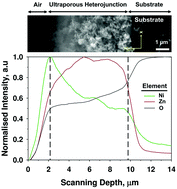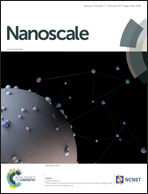Three-dimensional nano-heterojunction networks: a highly performing structure for fast visible-blind UV photodetectors†
Abstract
Visible-blind ultraviolet photodetectors are a promising emerging technology for the development of wide bandgap optoelectronic devices with greatly reduced power consumption and size requirements. A standing challenge is to improve the slow response time of these nanostructured devices. Here, we present a three-dimensional nanoscale heterojunction architecture for fast-responsive visible-blind UV photodetectors. The device layout consists of p-type NiO clusters densely packed on the surface of an ultraporous network of electron-depleted n-type ZnO nanoparticles. This 3D structure can detect very low UV light densities while operating with a near-zero power consumption of ca. 4 × 10−11 watts and a low bias of 0.2 mV. Most notably, heterojunction formation decreases the device rise and decay times by 26 and 20 times, respectively. These drastic enhancements in photoresponse dynamics are attributed to the stronger surface band bending and improved electron–hole separation of the nanoscale NiO/ZnO interface. These findings demonstrate a superior structural design and a simple, low-cost CMOS-compatible process for the engineering of high-performance wearable photodetectors.



 Please wait while we load your content...
Please wait while we load your content...